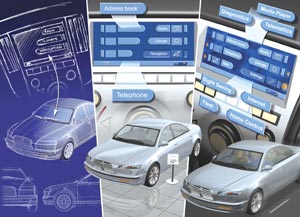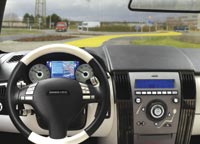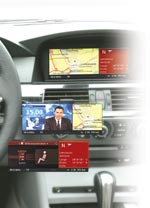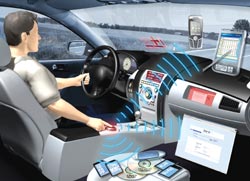The fully networked car
An ITU workshop at the Geneva International Motor Show focuses on ICT in vehicles
Major car
manufacturers are looking to incorporate some level of information and communication technology (ICT) functionality into their vehicles. The fully
networked car is a goal of manufacturers seeking to offer improved safety and a
better experience for the driver. ITU is joining hands with the International
Organization for Standardization (ISO) to host a workshop to share views on how
that future will unfold. The workshop will focus on the synergy between ICT and
the automotive sector.
Branded “The Fully Networked Car: A Workshop on ICT in Vehicles”, this unique
meeting of key players from the automotive and ICT sectors will take place from
2 to 4 March 2005 during the Geneva International Motor Show, one of the world’s
largest automobile events. The workshop’s objectives are threefold:
- to exchange ideas on the future of ICT in motor vehicles, with an emphasis
on standardization between the automotive and telecommunication industries;
- to examine topics important to decision-makers such as the need for
consensus between the public and private sectors and business models for
interlinking the car and telecommunication businesses;
- to examine technical topics such as telematics, diagnostics, safety, the
integration of in-vehicle systems with existing telecommunication
infrastructures, communications and the mobile office.
|
 |
|
Siemens |
This workshop is the second in a series to be organized by the ITU
Telecommunication Standardization Sector (ITU–T). The first one took place in
2003 and saw the formation of the “Advisory Panel for Standards Cooperation on
Telecommunications related to Motor Vehicles”. This panel has since held several
meetings, and is spearheading the March 2005 workshop. ICT in cars has become an
area of significant interest and impact to all major car manufacturers. A panel
of global experts will frame the major issues and engage the audience in
discussion on this important topic. Among the speakers are high-level
representatives from BMW, Bosch, Cisco Systems, France Telecom, Magna
Electronics, Motorola, Nissan, NTT DoCoMo, PSA Peugeot Citroën, Swisscom and
Volvo.
One key area of discussion is the introduction of systems that allow
communication with nearby vehicles warning them, for example, that a car is
hydroplanning and signalling the appropriate action to be taken. Another is how
automatically generated “in-vehicle” emergency calls (e-calls) can speed up
emergency service response and save lives. On the policy front, consensus among
the public and private sectors is needed to address overlaps between safety,
security, privacy and liability issues.
A panel of stakeholder representatives will address how multiple business
models converge, evolve and become replaced over time as market forces determine
the best value propositions for the technology being advanced. Examples from
specific stakeholder groups will look to explain why the commercial elements of
this new telematic ecosystem cannot follow a pre-defined plan, and discuss the
level of variation and business models that can evolve with early participation
in the standards, technology development and implementation. In the United
States, for example, the Vehicle Infrastructure Integration (VII) initiative is
investigating the potential for two-way, vehicle-to-vehicle and
vehicle-to-roadside communications to provide a new suite of services to the
operators of automobiles, trucks and buses, according to Joyce Wenger of Booz
Allen Hamilton. Ms Wenger’s presentation to the workshop underlines that a
systems perspective is needed to address the technical, economic, cultural and
political challenges.
| Promoting new technologies to improve road safety
|
Road crashes are the second leading cause of death globally among
young people aged 5 to 29 and the third leading cause of death among people
aged 30 to 44 years, according to a joint report launched by the World Health
Organization (WHO) and the World Bank in April 2004. “Road crashes kill 1.2
million people every year and injure or disable as many as 50 million more,”
states the World report on road traffic injury prevention. Without
immediate action to improve road safety, the report estimates that road traffic
deaths would increase by 80 per cent in low- and middle-income countries by
2020. The economic impact, too, is significant. In low- and middle-income
countries, the cost of road traffic injuries is estimated at USD 65 billion,
exceeding the total amount these countries receive in development assistance.
Road traffic injuries are reported to cost countries between 1 and 2 per cent of
gross national product, amounting to USD 518 billion every year. The report
provides governments and other policy-makers, industry, non-governmental
organizations, international agencies and individuals with concrete
recommendations to improve road safety.
European E-Safety Initiative
The e-call
In the battle for road safety, the European Union has set itself an ambitious
goal to halve the number of deaths by 2010. According to the White Paper of the
European Commission, issued in September 2001, death on a daily basis accounted
for 40 000 fatalities a year. Through the “European transport policy for 2010:
time to decide”, the Commission is marshalling efforts towards meeting this
target. The Commission has committed itself to promoting new technologies to
improve road safety. Implementing a harmonized vehicle-related “European
Emergency Call Service” is the number one priority of the European eSafety
programme.
| European E-Safety Initiative |
 |
| Source: SIEMENS VDO Automative. |
Since 25 July 2003, fixed and mobile network operators are required to
provide caller location information to emergency service centres responding to
112 calls (including automatic e-calls) under the Universal Service Directive
2002/22/EC. The EU, along with the European Association of Car Manufacturers
(ACEA) and ERTICO — the European, not-for-profit, public/private partnership for the
implementation of intelligent transport systems (ITS) — signed a memorandum of understanding that aims to realize an interoperable,
pan-European in-vehicle emergency call. Experts at the workshop will discuss how
in-vehicle emergency calls (eCall) can speed-up the response of the emergency
services and potentially reduce the number of fatalities, severity of injuries
and stress in post-crash situations.
“A cost-effective e-call solution has been elusive for the best part of a
decade. Most carmakers who have offered telematics in their vehicles have
included a form of emergency voice call with vehicle positioning, generally with
a telematics service provider as the intermediary to the local public safety
answering point (PSAP). This model has proven complex and costly and a large
proportion of customers have not been renewing subscriptions for this and other
services offered after the initial ‘free’ period for telematics services,”
explains David Horncastle of Ygomi LLC, London.
Mr Horncastle underlines that: “While car buyers generally agree that some
form of emergency notification is a good thing to have in their vehicle, what
they are keen to avoid is a complicated subscription arrangement with monthly or
annual fees, particularly when the additional services offered by the car maker
may duplicate some of those they can already enjoy with their mobile phone (and
therefore access anywhere, rather than being limited to in-car use)”. Experts at
the workshop will discuss some of the concepts being developed to address many
of the issues associated with a robust, reliable emergency notification
solution, with specific emphasis on data-only messaging known as Automatic Crash
Notification (or ACN) being envisaged in Europe and the United States.
 |
| Siemens |
One of the most crucial questions to be solved when implementing an
e-call-service is getting the appropriate rescue forces to be detached to the
site of an accident, explains Ralf-Roland Schmidt-Cotta of Siemens VDO
Automotive AG. In other words, under which conditions should an e-call be
triggered? To answer these questions, a set of crash parameters and the
evaluation procedure have to be defined. To avoid a high ratio of idle and
expensive rescue trips, a complex accident detection and evaluation process has
to be in place. Research carried out in recent years has shown that the use of
devices such as accident data recorders can not only improve the quality of
accident reconstruction, but also help to change driving behaviour. And so a new
European project called VERONICA (vehicle event recording based on intelligent crash assessment) has been
launched to study, among other things, the technical, legal and organizational
aspects related to vehicle accident data recorders. VERONICA brings together car
manufacturers, enforcement authorities, telematic, accident reconstruction and
legal experts. The requirements of the “Golden hour” for the rescue service are
part of the project, whose leadership was awarded to SIEMENS VDO Automotive AG
on 22 December 2004. “Standardization of accident data is indispensable
for an e-call system in Europe,” underlines Mr Schmidt-Cotta.
In the United States, the state of New Jersey is reported as the largest
911network nationwide. Recently, the network went under a thorough review and
plans are under way to build a new 911 network that will evolve as the
next-generation E911 network. During the workshop, expect some spotlight on
basic 911, enhanced 911 and on next-generation E911 in the United States with
specific comments relative to ACN and the need for the public and private sector
to interconnect now.
Japan’s Quasi-Zenith Satellite System to upgrade location-based services
Japan is developing its new Quasi-Zenith Satellite System (QZSS) through a
public-private partnership “in order to upgrade various kinds of location-based
services”, according to Motoyuki Kohn, Deputy General Manager of Business
Development at the Advanced Space Business Corporation (ASBC). An overriding
goal of Japan’s ITS policy is to reduce social cost of traffic accidents. QZSS is
expected to broadcast highly precise positioning information and so improve road
safety and security. In 2004, the number of traffic fatalities in Japan was
7358, representing a decrease of 344 (or 4.5 per cent) from 2003. “To achieve
our new target of 5000 or fewer fatalities per year by 2012, further efforts are
needed to promote comprehensive measures for traffic safety,” says Masatoshi
Morita, Assistant Director for ITS Traffic Planning Division, Traffic Bureau at
the National Police Agency of Japan.
In recent years, emergency calls (“Dial 110 calls”) from mobile phones have
been increasing very rapidly and now account for more than half the total number
of emergency calls. In many cases, though, it is difficult to identify the
location of a caller, which causes delay in the arrival of emergency
vehicles. The National Police Agency has developed its Help System for Emergency
Life Saving and Public Safety (HELP). With HELP, when an emergency incident
occurs while driving, an in-vehicle unit and a cellular phone automatically
transmit caller location information obtained from the Global Positioning System
(GPS) to the operation centre. This then automatically activates voice
communication with the operation centre staff by either manually turning on the
“HELP switch” of an in-vehicle unit or by the automatic call activation function
of the impact detector.
QZSS, with its constellation of three satellites, will complement and
reinforce the civilian function of the US Global Positioning System. Each
satellite will stay eight hours around the Zenith over Japan, taking turns to
provide unified communication, broadcasting and positioning services, explains
Mr Kohn. Because one satellite would remain overhead at all times, QZSS is
expected to transmit signals without obstruction from tall buildings or
mountains. This is welcome news in a country like Japan where mountainous
terrain and urban canyons do not allow a clear skyline to the horizon.
| Seamless communications on the move
|
 |
|
Siemens |
Supporting communication between anyone, any device, anytime and
anywhere is becoming the major challenge for the makers of future
telecommunication network platforms. A major goal is to bring to market
multimedia communication solutions with seamless network interconnectivity for
business customers on the move. One of the sessions will cover the evolution
towards ubiquitous applications and services as well as in-vehicle solutions.
|
North American telematics market |
|
Automotive telematics |
2001 |
2002 |
2003 |
2004 |
Vehicle manufacturers
offering telematics |
12 |
15 |
19 |
25 |
|
Models offering telematics |
51 |
67 |
88 |
101 |
|
Average price of telematics |
USD 2218 |
USD 1900 |
USD 1238 |
USD 922 |
|
Sale of telematics-enabled autos |
USD 1630 000 |
USD 2020 000 |
USD 2450 000 |
|
|
Source: The Status of Automotive Telematics in North America,
Telematics Research Group: April 2004
(http://www.telematicsresearch.de/PDFs/TMpress042104.pdf?PHPSESSID=01a1d09361faf7846e772bc7a3d65aa9). |
“Radio and TV Broadcasters have chosen to use digital transmission technology
in many ways in addition to simply rolling out large numbers of sound radio and
television services” says Edgar Wilson of the European Broadcasting Union (EBU).
Examples range from television to public transport in Singapore (DVB-T), high
definition television (HDTV) in Australia, digital multimedia broadcasting (DMB)
to handheld devices in the Republic of Korea, and DVB-H television services to
mobile phones in Finland. Mr Wilson adds. “We will examine some of the
strategies that are unfolding for launching broadcast services to mobile users,
particularly for passengers in cars and public transport. The consumption of
broadcast services is becoming increasingly personalised, and using devices
which combine broadcasting with mobile telecommunications, the consumer is able
to stay informed, educated, entertained and interacting whenever and whenever
he wishes.” The workshop will no doubt address the needs and the value of
selecting pieces of the telematics value chain for standardization that will
provide an enabler for industry growth.
| Consumers likelihood to buy telematics |
 |
| Source: GartnerG2, “Telematics Industry Outlook: Think
‘Outside the Vehicle’,” September 2002.
|
Mobile device integration: Bluetooth in the car
Keep your hands free for driving!
 |
|
Siemens |
| An infotainment system that can be extended with new functionalities. An
ergonomic user interface provides safety and comfort |
In recent years, several car manufacturers have found Bluetooth to be an
effective method for extending the mobile phone experience in the car. Bluetooth
is a short-range wireless standard that was designed to replace proprietary
cables between a wide range of computing and communication devices. Bluetooth
operates in the unlicensed 2.4 GHz range of spectrum and is capable of
transmitting at a speed of 1Mbit/s over a range of 10 metres. Another feature of
Bluetooth is that it uses a combination of packet and circuit technologies,
allowing quality-of-service guarantees for transmissions such as voice and
video, while giving less priority to general data packet transmissions.
Bluetooth devices establish network connections by listening for other
Bluetooth-enabled devices within range and then initiating contact. Common
examples include Bluetooth wireless headsets for mobile phones and wireless
keyboard/mouse combinations for computers.
Bluetooth technology in cars helps keep hands free for driving. Some of the
latest car models allow Bluetoothenabled phones to connect wirelessly to the
car to make calls. Once the phone and the car have made an initial pairing,
controls on the steering column can activate the phone and dial preset numbers.
In addition, the user can simply say the telephone number and voice recognition
software in the car will dial that the number. The status of the call is
displayed on the dashboard of the car (for example, the number dialled, signal
strength and battery level of the telephone). The voice of the person on the
other end of the call is then routed through the sound system of the car as a
hands-free speakerphone conversation.
The car’s GPS navigation system provides real-time location-based information
about restaurants, hotels, movie theatres, garages and other services in the
area, which can be dialled by the car over a Bluetooth connection with the
simple click of a button. As well, various car manufacturers have unveiled
products that connect Apple’s popular ipod player to their infotainment systems,
thus extending the range of consumer devices that become integrated into cars.
The workshop will address human-machine interface issues that arise when
external consumer devices are brought into the car. It will also outline
opportunities and risks of integrating consumer devices into cars, and finally
discuss whether mobile devices could boost the telematics market that has slowed
down in recent times.
|







